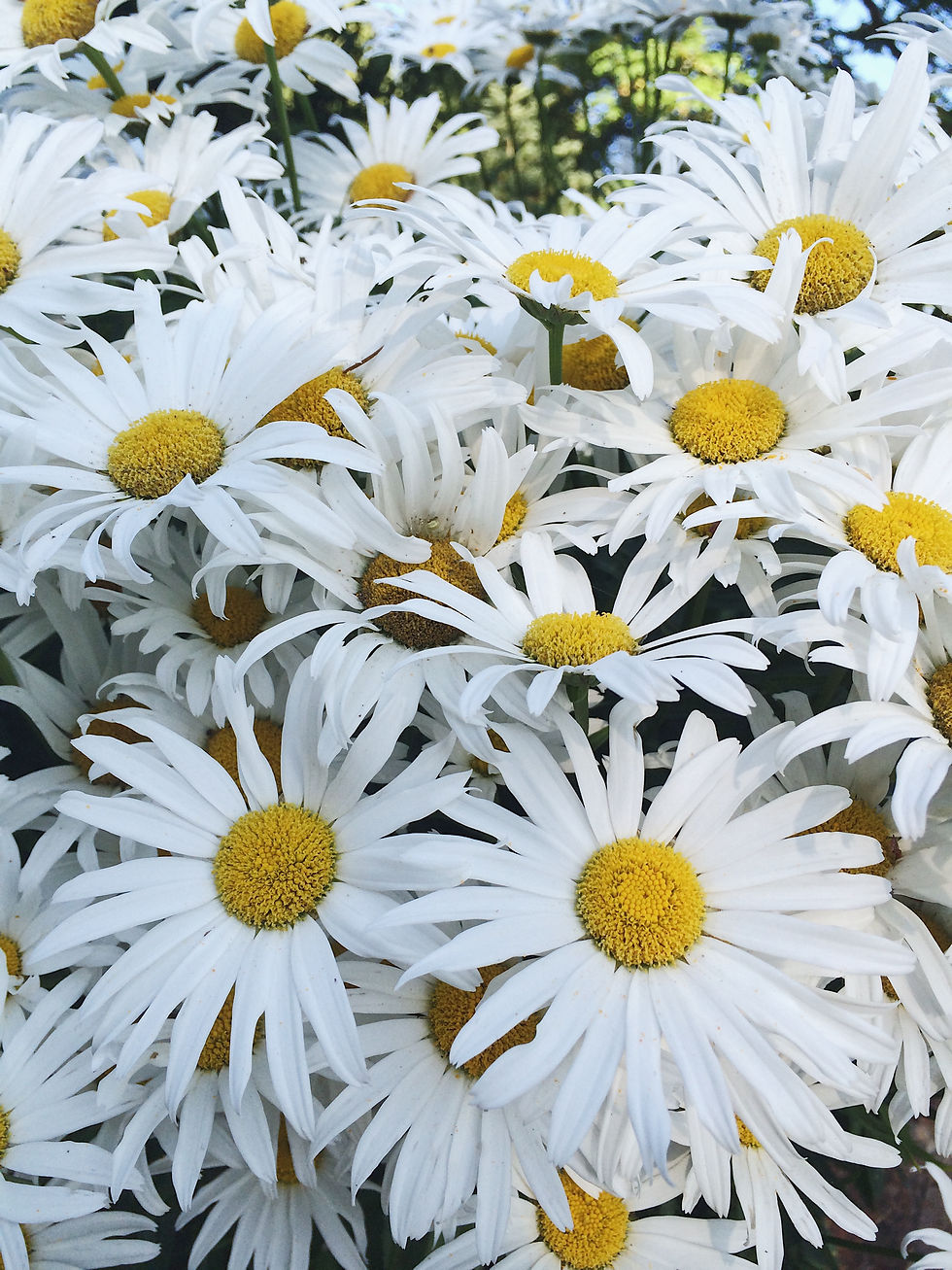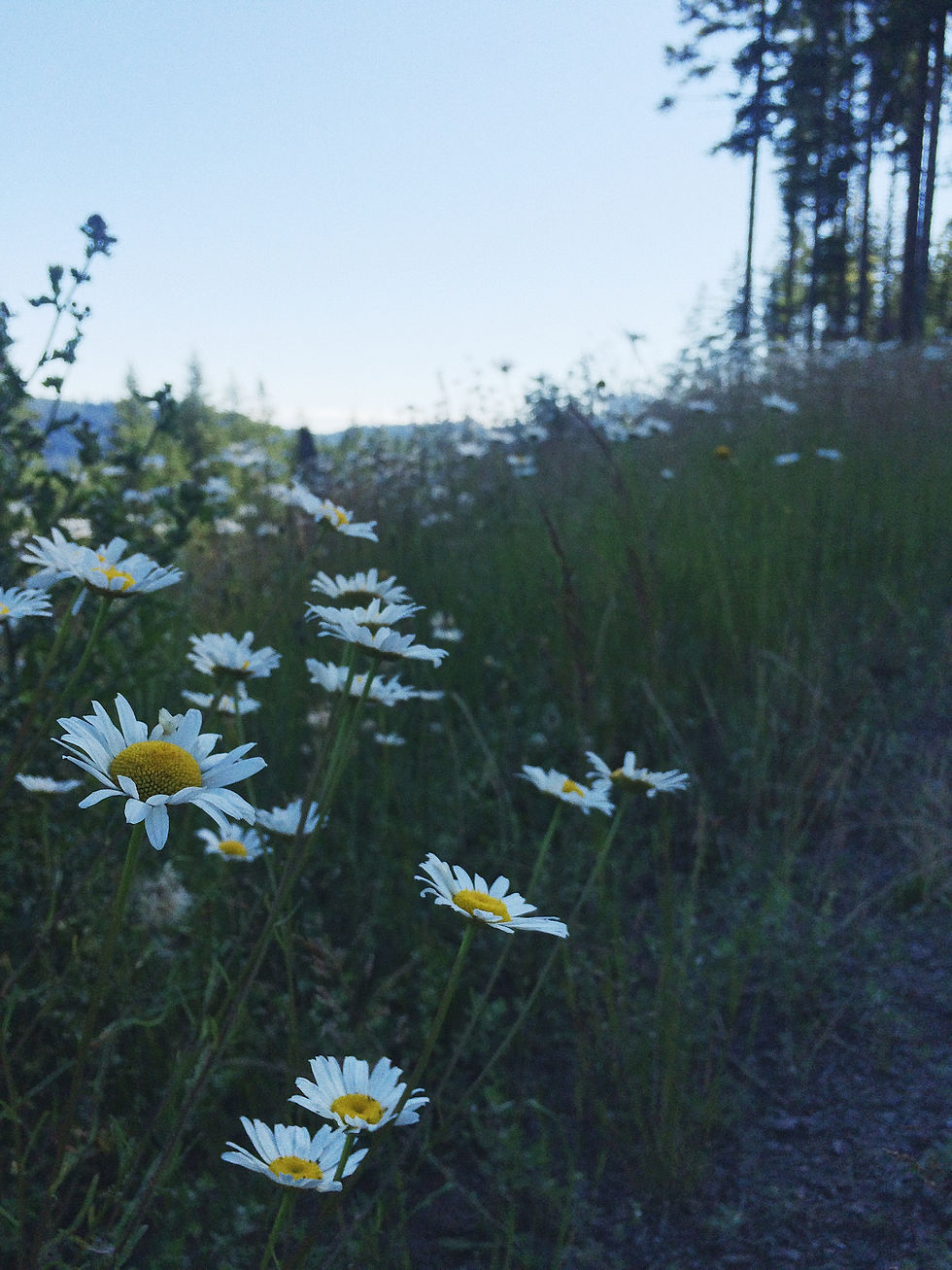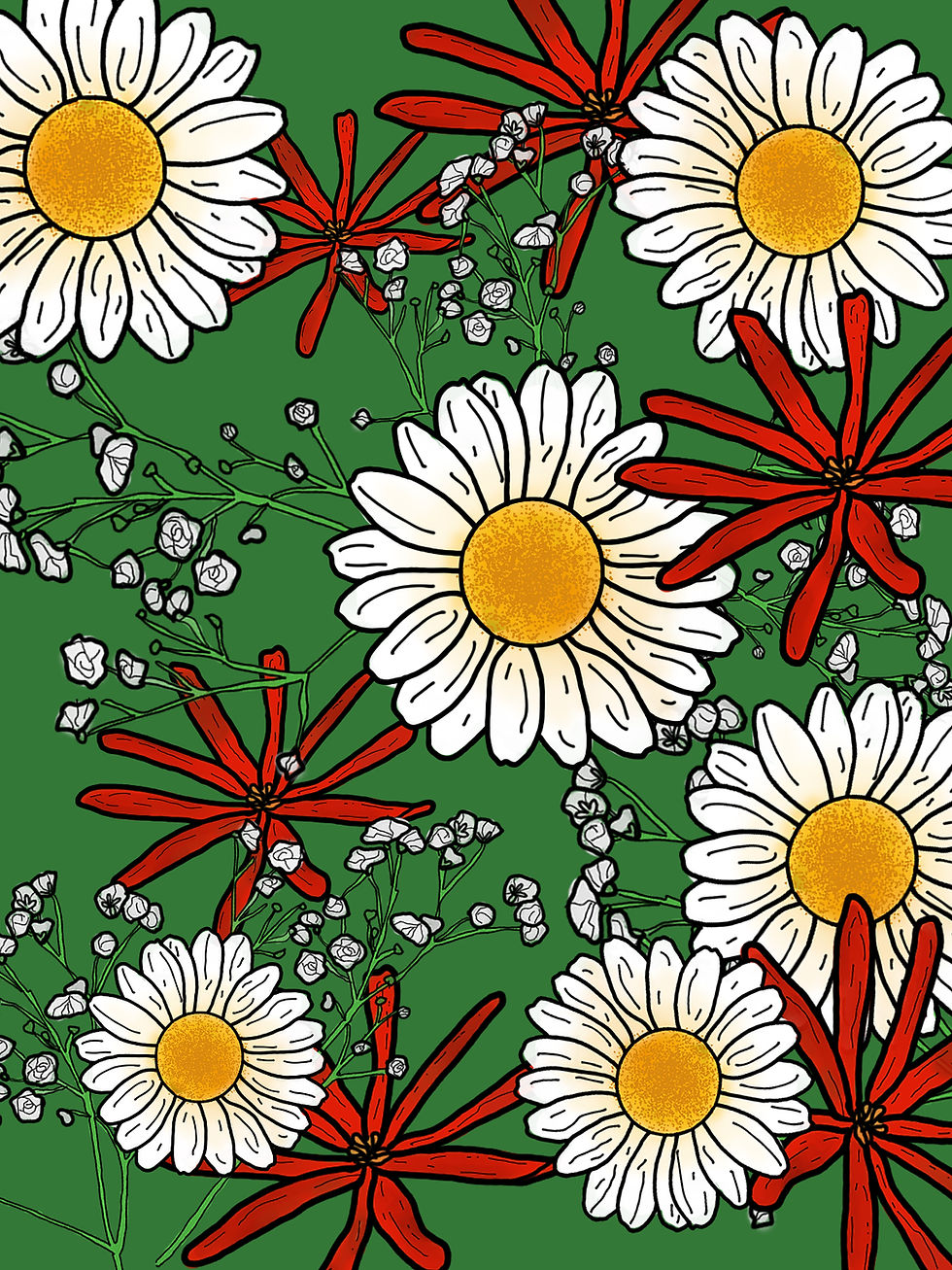DAISY
- Erin Brudi

- Jul 6, 2020
- 10 min read
Innocence
Cheerfulness
Beauty unknown to the Possessor

NATURAL BACKGROUND:
As one of the most commonly recognised flowers, daisies spring from the earth in various locations and is resilient to multiple types of soil. (1) Scientifically known as Bellis perennis, daisies are a well-known wildflower throughout Europe. (2) Although, originally considered a weed, daisies and many daisy varieties, are popular in gardens, bouquets, and prints. (3)
Daisies, and the varieties within the daisy family, are often easy to identify due to the common appearance of the flower head itself and the multiple elongated petals forming at least one row if not more. (4) Daisies are known to open their petals in fair weather while closing their petals at night and during stormy and rainy weather. (5)
HISTORY:

Daisies are a natural wildflower throughout Europe, and therefore have been documented from very early years. The name of the flower itself has a rich history. Some state the name Daisy was made popular by Chaucer; the flower is called a Daisy or an “ee of the daie [sic]” due to the flower opening and closing at night; additionally, Ben Jonhson wrote it as “Day’s Eye”. (6) The name Gowan also refers to the daisy and is used primarily in northern England and Scotland. (7) Some etymologists believe Gowan came from the Gaelic gugan (flower or bud) whilst others disagree and believe it to stem from the word gollan or golland (gold). (8) In France, the daisy was often called Marguerite deriving from the word for ‘pearl’. (9) Both the french term of Marguerite and the Celtic term Gowan are now popular variants of daisies within the general Daisy family; there are over 90 species relating to Daisy, Gowan, and Marguerite. (10)
Historically speaking, the daisy was often described as a yellow centre with rows of petals closing at night and in poor weather. (11) Due to this general description, it is possible that many of the folklore and legends surrounding daisies could have actually been describing another flower, most likely a white chrysanthemum. (12)
FOLKLORE:

Due to their long history throughout Europe, many myths, legends, and folklore surround the daisy. Generally, daisies are thought to represent children and childhood and many of the tales surrounding the daisy reflect these themes.
One of the most popular tales about the daisy comes from the poems of Ossian and tell of a woman named Malvina. The story goes that Malvina was a young soon-to-be mother who had lost her son. Malvina wept for her child and was comforted by the maids of Morven. While consoling Malvina in her grief, the maidens sang softly to her:
“The child which hath not seen the light hath not known the sorrows of life: his young spirit, borne aloft on glittering wings, soars to the abodes of everlasting day. The souls of infants who, like thine, have burst without pain in the bonds of life, reclining on golden clouds, appear and open to him the mysterious portal of the manufactory of flowers. There these innocents are continually employed in enclosing the flowers that the next spring shall bring forth in imperceptible germs: these germs they scatter every morning over the earth with the tears of the dawn. Millions of delicate hands enwrap the rose in its bud, the grain of corn in its husk, the mighty oak in a single acorn, a whole forest in an imperceptible seed.” (13)
The maidens comforted Malvina and told her of her lost son who had “poured upon our fields a fresh harvest of flowers… among these flowers there is one with a golden disk, encircled with rays of silver, tipped with a delicate tint of crimson.”(14) The maidens continued to comfort Malvina by telling her they had seen her lost child “waving amid the grass in a gentle breeze, it looks like a little child playing in a green meadow. Dry thy tears, O Malvina!... the flower of thy bosom has given a new flower to the hills of Cromla.” (15) This flower mentioned by the maidens being the daisy. Malvina was comforted by the maidens’ song and the maidens of King Morven “consecrated the Daisy to infancy. It is, they say, the flower of innocence, the flower of the newborn.” (16)
Variations of Malvina’s tale include the idea that when a child passes away before or recently after birth, an angel “throws a daisy down upon the earth to console the bereft parents” as well the belief that every unborn child returns “to the earth as a new flower”. (17) Another Celtic belief speaks of infants and children wearing daisy chains to protect them from faeries carrying them away. (18)
Chaucer, in his Legendes of Goode Women, writes about the daisy symbolising fidelity due to Queen Alceste sacrificing her life in order to save her husband. Queen Alceste was then turned into the daisy due to her fidelity; each virtue was represented by a petal. (19)
Frederic Shoberl, in his The Language of Flowers with Illustrative Poetry, written in 1841, retells another popular tale concerning the origins of the daisy:
“Fabulous history informs us that the Daisy owed its origin to Belides, one of the nymphs called Dryads, who were supposed to preside over meadows and pastures. While dancing on the turf with Ephigeus, whose suit she encouraged, she attracted the admiration of Vertumnus, the deity who presided over orchards; and to escape from him, she transformed into the humble flower, the Latin name of which is Bellis.” (20)
Some, however, believe this myth to be completely false “because the English Bellis perennis was not known to the classical ancients from whom, to judge by the proper names, the story would be supposed to have come.” (21)
The daisy is extremely popular within religious tradition. The daisy is said to be symbolic of St. Margaret of the Dragon, Margaret of Cortona, St. John, St. Barnabas, and St. Augustine. (22) Additionally, there are two similar stories concerning the daisy both in relation to Mary the mother of Jesus as well as Mary Magdalene. The stories, both the nearly the same, tell “Daisies came to represent Mary’s tears when she pricked her finger while picking daisies to give to baby Jesus. A little blood smeared on to the petals, giving them a pink tinge” but these stories specifically state Mary as either being Mary Magdalene after Jesus’ crucifixion as well as Mary the mother of Jesus after his birth. (23)
Two christ child legends surrounding the daisy are also quite popular. The first legend tells of King Malcher and the wise men searching for the newborn king and realising they were in the correct location due to a flower “rayed like the start” that had guided them. (24) The second legend tells of a family on Christmas eve in the Black Forest region of Germany. The tale states a family had come upon a deserted child on their doorstep shivering from the cold. The family brought the child into their home and offered him a plate filled with items that each family member had sacrificed for the deserted child. After caring for the child and placing the plate before him “the blanket fell away and he was revealed in shining white with a halo around his head. ‘I am the Christ Child,’ he announced, and thereupon vanished.” (25) The next morning two white flowers were found blooming in the place he had stood the evening before. Both stories revolve around a white flower being found, this flower is often debated to be either a daisy or a white chrysanthemum. (26)

Other stories and superstitions surrounding the daisy include the thought that it is lucky to dream of daisies, but only good luck to dream of them in spring and summer; dreaming of daisies in autumn and winter bring bad luck. (27) Some girls were known to place daisies under their pillows at night in order to dream of their lovers. (28)
Daisies also announce the arrival of spring; “spring has not sprung until you put your foot on twelve daisies… if you don’t put your foot on the first twelve daisies you see in spring, then daisies will be sure to grow over you or one of your loved ones before the year is out.” (29)
MEDICINAL USES:
Throughout history, daisies have had multiple purposes. The leaves, roots, and flower head of daisies are edible and have also been used for medicinal purposes. (30) There are some accounts of ancient roman surgeons instructing their slaves to gather baskets of daisies “to help staunch bleeding wounds”. (31) They would then soak bandages in juice extracted from the daisies and apply these bandages to major cuts from swords and spears. (32)
Daisies could also be made into various ointments. These ointments were applied to topical skin imperfections such as acne, bruises, varicose veins, boils and could also be used as a burn ointment. (33) Additionally, when made into an ointment or ‘juice’ it was thought that daisies helped to clear the eyes. (34) It was also thought that daisies helped to heal and prevent the ageing of bones and was often referred to as the ‘bone flower’. (35) When boiled, daisy water was thought to cure skin discolouration, eczema, and acne, as well as being helpful for breaking a fever and “heating up the liver and all internal organs”. (36) Chewing the leaves of daisies was thought to cure mouth ulcers; the leaves could also be used as a “culinary herb”. (37) The daisy is known to be an anti-inflammatory herb, improve circulation, as well as being a diuretic.( 38) Daisies, historically, have been used to help several ailments such as joint pain, colds, headaches, stomach and liver aches, skin ailments, tuberculosis, coughs, pleurisy, ringworm, gout, and more. (39) When made into a tea, it is thought the daisy creates “health-giving and restorative properties”. (40)
DAISIES IN POP CULTURE:

Due to its long history, daisies became extremely popular in both Victorian societies as well as today’s pop culture. The Daisy Chain first published in 1856 was an extremely popular novel describing the familial lives of motherless children. (41) Similar to the sunflower, the daisy also became a common theme throughout the Aesthetic Movement. William Morris created his ‘Daisy’ wallpaper which was exceedingly popular for over fifty years; this wallpaper was often bought for bedrooms of young girls and maids. (42)
Daisies were often mentioned in multiple poems in the victorian Romantic movement, which focused on natural themes. (43) Many poets, such as John Clare, Robert Burns, Ben Jonson, William Wordsworth, and many others mention the simple daisy in their poems. Perhaps the most famous poet to draw attention to this simple flower was Shakespeare, who commented on the daisy “whose white investments figure innocence.” (44) In Love’s Labour’s Lost Act V Scene 2, Shakespeare writes:
When daisies pied, and violets blue,
And lady-smocks all silver white,
And cuckoo-buds of yellow hue,
Do paint the meadows with delight.”
Most notably, the daisy is mentioned throughout the play Hamlet. In Act IV Scene 5 a description of beautiful garlands of flowers, specifically crow-flowers, nettles, and daisies, are mentioned. In Act IV Scene 7 Ophelia goes about the court giving out flowers, although she announces the daisy, she does not give it away, some suggest this is a statement describing “there is no innocence or purity within the court”. (45) Ophelia is often linked to the daisy due to her early death and the loss of her innocence after her drowning.
Daisy became a popular name both in literature and in society. In 2010 the name Daisy was the 15th most popular name in England and Wales. (46) Daisy is also the name of the female protagonist in F. Scott Fitzgerald’s The Great Gatsby. In the popular Super Mario Bros video games, a character is also named Princess Daisy. In 1958 and again in 1962 two hurricanes were named Daisy as well. (47)
SYMBOLISM:
Mainly in part due to the surrounding folklore, daisies have become synonymous with innocence and childhood. This remains true within floriography. However, there are additional meanings attributed to the daisy within floriography for various reasons which we have no substantial evidence for.

Some floral dictionaries give a brief background to the attached meanings of both the double daisy as well as the Michaelmas daisy:
Double Daisy: Participation
“The cultivated daisy is made the emblem of participation, because its multiplied petals all partake of one receptacle.” (48)
Michaelmas Daisy: Afterthought, Farewell, Cheerfulness in Old age
“We present these flowers as the happy emblem of cheerfulness in old age, since, like that blessing, it lengthens the summer of our days, and contributes towards the enlivening of all who compose its circle.”(49)

The illustration depicts a possible bouquet containing daisies, baby’s breath, and red catchflies. This bouquet could convey a pure, and youthful love.
Daisy (innocence) + Baby's Breath (pure of heart) + Red Catchfly (youthful love)
Daisies are an extremely popular and well-loved flower throughout history and even today. There’s no doubt the daisy has brought significant meaning throughout multiple cultures and time periods. How would you translate a bouquet of daisies?
TO LEARN MORE:
Arricca SanSone. “How to Grow Daisy Flowers.” Country Living, Country Living, 24 May 2018, www.countryliving.com/gardening/a22109231/outdoor-daisy-flower-care/. Accessed 3 July 2020.
Boeckmann, Catherine. “Shasta Daisies.” Old Farmer’s Almanac, www.almanac.com/plant/shasta-daisies. Accessed 3 July 2020.
Campbell, Mike. “Namesakes for the Name Daisy.” Behind the Name, www.behindthename.com/name/daisy/namesakes. Accessed 3 July 2020.
Yonge, C M. The Daisy Chain; or, Aspirations. A Family Chronicle. London, 1856.
“Daisies and Pansies | A Shakespeare Garden.” Daisies and Pansies | A Shakespeare Garden, bardgarden.blogspot.com/2014/11/daisies-and-pansies.html. Accessed 3 July 2020.
Dorothea Lynde Dix, and Cairns Collection Of American Women Writers. The Garland of Flora. Boston, S.G. Goodrich And Co. And Carter And Hendee, 1829.
Esling, Catharine H. Watermen. Flora’s Lexicon : An Interpretation of the Language and Sentiment of Flowers, with an Outline of Botany, and a Poetical Introduction. Philadelphia, Herman Hooker, 1839.
Fitzgerald, F S. The Great Gatsby. Harmondsworth, Penguin Books, 1950.
Greenaway, Kate. Language Of Flowers. London, George Rutledge & Sons, 2016.
Hooper, Lucy. The Lady’s Book of Flowers and Poetry; to Which Are Added a Botanical Introduction, a Complete Floral Dictionary and a Chapter on Plants in Rooms. Philadelphia, J.C. Riker, 1846.
Kell, K.T., 1956. The Folklore of the Daisy. The Journal of American Folklore, 69(271), pp.13–21.
Kirkby, Mandy. The Language of Flowers : A Miscellany. London, Macmillan, 2011.
Mccabe, James D. The Language and Sentiment of Flowers. 1890. Bedford, Massachusetts, Applewood Books, 2003.
Moodenbaugh, Robert. “Daisy - A Foraging Guide to Its Food and Medicine.” EATWEEDS, 20 July 2019, www.eatweeds.co.uk/daisy-bellis-perennis. Accessed 3 July 2020.
Osgood, Frances S. The Poetry of Flowers and the Flowers of Poetry. New York, J.C. Riker, 1841.
Phillips, Henry. Floral Emblems. London, Saunders and Otley, 1825.
Richardson, Rosamond. Britain’s Wild Flowers : A Treasury of Traditions, Superstitions, Remedies and Literature. London, National Trust, 2017.
Shakespeare, W., & Hibbard, G. R. (1994). Hamlet. Oxford, Oxford University Press.
Shakespeare, W., & Woudhuysen, H. R. (2001). Love's labour's lost. [London], Arden Shakespeare.
Shoberl, Frederic. The Language of Flowers with Illustrative Poetry. edited by Louise Cortambert and Louise-Aime Martin, Philadelphia, Lea & Blanchard, 1848.
Tyas, Robert. The Sentiment of Flowers; or, Language of Flora. edited by James Andrews, 9th ed., London, R. Tyas, 1842.
“Victorian Era Poetry Characteristics & Salient Features.” Victorian-Era.Org, 2019, victorian-era.org/victorian-era-poetry-characteristics.html.
Wirt, Elizabeth. Flora’s Dictionary. Baltimore, Fielding Lucas Jr., 1832.
ENDNOTES:
Catherine Boeckmann, “Shasta Daisies”.
K.T. Kell, The Folklore of the Daisy, 13.
Ibid.
Ibid.
Lucy Hooper, The Lady’s Book of Flowers and Poetry, 71.
Frederic Shoberl, The Language of Flowers with Illustrative Poetry, 55 and Rosamond Richardson, Britain’s Wildflowers, 93 and Hooper, The Lady’s Book of Flowers, 71.
Kell, The Folklore of the Daisy, 14.
Ibid, 14.
Ibid.
Ibid, 15.
Hooper, The Lady’s Book of Flowers, 71 and Kell, The Folklore of the Daisy, 13.
Kell, The Folklore of the Daisy,17.
Frederic Shoberl, The Language of Flowers, 58.
Ibid.
Ibid, 58-59.
Ibid, 59.
Mandy Kirkby, The Language of Flowers 43, and Kell, The Folklore of the Daisy, 16.
Richardson, Britain’s Wildflowers, 93-94.
Kell, The Folklore of the Daisy, 16.
Frederic Shoberl, The Language of Flowers, 55.
Kell, The Folklore of the Daisy, 16.
Ibid.
Richardson, Britain’s Wildflowers, 93.
Kell, The Folklore of the Daisy, 17.
Ibid.
Ibid, 17-18.
Richardson, Britain’s Wildflowers, 94.
Ibid.
Ibid.
Robert Moodenbaugh, "Daisy- A Foraging Guide".
Richardson, Britain’s Wildflowers, 94.
Ibid.
Ibid and Moodenbaugh, "Daisy".
Richardson, Britain’s Wildflowers, 94 and Moodenbaugh, "Daisy".
Moodenbaugh, "Daisy".
Richardson, Britain’s Wildflowers, 94 and Moodenbaugh, "Daisy".
Richardson, Britain’s Wildflowers,94.
Richardson, Britain’s Wildflowers, 94 and Moodenbaugh, "Daisy".
Ibid.
Moodenbaugh, "Daisy".
C.M, Yonge, The Daisy Chain.
Kirkby, The Language of Flowers, 44.
Victorian Era Poetry”.
Shoberl, The Language of Flowers, 55.
"Daisies and Pansies”.
Mike Campbell, “Behind the Name”.
Ibid.
Henry Phillips, Floral Emblems, 29.
Ibid, 90.




I will never look at “Days Eyes” the same again. Thanks for the information about this pretty little flower.